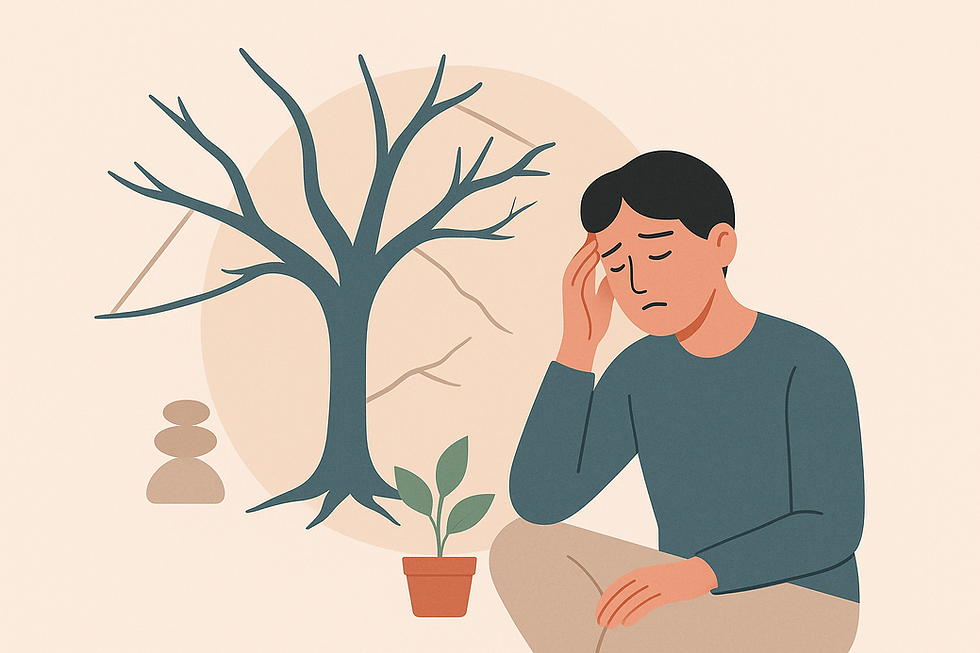Men, Mental Health, and the World: A Call to Action
- Anjali Gulati
- Nov 17, 2024
- 3 min read

There’s an unspoken rule many men follow: emotions are weakness, and silence is strength. It's passed down like a family heirloom—valuable but flawed. Globally, the narrative of what it means to "be a man" is being dismantled, not in grand declarations but in quiet revolutions happening in homes, workplaces, and conversations.
A friend once told me about his father, who hadn’t hugged him since childhood. It wasn’t because he didn’t love him; it was simply just ‘not done’. Men were expected to provide, protect, and, somewhere along the way, forget how to feel. That silence has snowballed into a crisis we cannot ignore anymore.
Behind the Silence
Statistically, men dominate the world of tragic endings: 77% of suicides worldwide are men. That’s not just a number—it’s millions of stories cut short because reaching out was too stigmatized, too far away from what is “acceptable.”

Look at the concept of toxic masculinity, a term so overused it risks losing meaning. Yet, at its core, it explains why men drink more, die younger, and seek less help. Conditioning runs deep. From the playground to the boardroom, vulnerability is perceived as a liability.
Boys are taught to suppress tears, and grown men have perfected the art of “I’m fine.”
But let’s zoom out. It’s not just “toxic masculinity” or societal norms—it’s the entire infrastructure of mental health. Services for men often don’t feel befitting to their needs. Therapy can seem alien, a “last resort” instead of the lifeline it is for so many.
Stories Hidden in Plain Sight
The story of a client I am naming here Ross (A fictional name) is one I keep coming back to. At 35, he had what looked like a picture-perfect life. He worked hard, played harder, and suppressed hardest. When his wife suggested therapy, he laughed it off. “I don’t need to talk to a stranger about my feelings,” he said.

A panic attack on a random Tuesday changed that.
Men like Ross exist everywhere—successful, seemingly content, but battling invisible wars. For every Ross who finds help, there are countless others who don’t. They suffer quietly, taking comfort in overwork, alcohol, or distractions.
Why Men's Mental Health Should Matter to Everyone

We tend to frame mental health as an individual concern, but men’s struggles show up outwardly more. They affect relationships, families, workplaces, and communities. A 2024 workplace survey highlighted how 59% of men experience unmanageable stress but are less likely to utilize wellness programs.
Their silence impacts team dynamics, decision-making, and even their physical health.
This silence costs—not just emotionally but economically. Depression and anxiety cost the global economy billions annually in lost productivity, and men’s reluctance to seek help exacerbates this.
Breaking the Cycle

Changing the script isn’t easy. It means reimagining what masculinity can look like:
1. Emotion as Strength:
Boys need to see men who cry, love openly, and admit fear. The narrative must shift from stoicism to emotional literacy.
2. Representation in Mental Health:
Campaigns like Movember have started a movement, but we need more relatable stories—ones that show men that seeking help doesn’t weaken them; it saves them.
Workplaces must also step up. Policies that address men’s unique stressors—financial fears, provider roles—aren’t a luxury; they’re a necessity.
Hope in Small Conversations
I remember a patient who, after weeks of therapy, said: “It feels like I’ve been holding my breath my whole life.” His healing began not in my office but when a colleague asked if he was okay and waited for an honest answer.
The revolution starts with small acts: a dad telling his son it’s okay to cry, a friend following up when a friend cancels plans, a workplace introducing anonymous mental health check-ins.
Regardless of who we are or what you do for a living or where you came from, it doesn't discriminate. - Dwayne 'The Rock' Johnson
No Grand Endings—Just Continuations
Men’s mental health doesn’t need a hero’s arc or a cinematic resolution. It needs steady, collective effort. As a psychologist, I believe the most profound changes often happen quietly: a man admitting to himself that he’s struggling, a friend saying, “I hear you,” a society deciding it’s okay to let men just be human.

It’s not about making men “man up.” It’s about letting them open up, break down, and rebuild. Because in the end, saving men isn’t just about saving them—it’s about saving all of us from a world where silence wins.
Take Action
Start the conversation. Share this blog, reach out to a friend, or just sit with the idea that vulnerability is strength. The more we talk, the less alone men will feel. :)



Comments